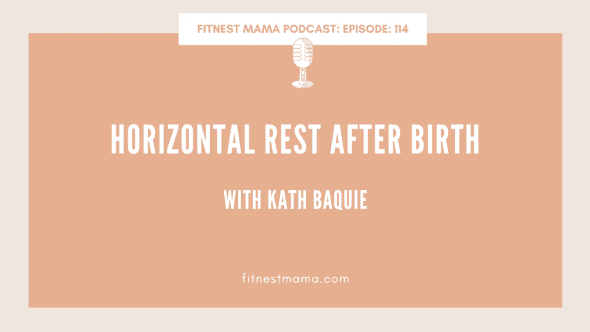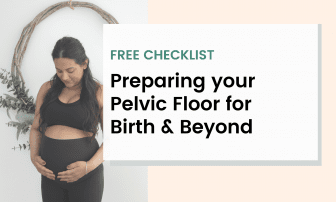After birth recovery … we all experience it differently, but we all need to help our bodies recover to some extent or other.
So, the all important question, how can we support our after birth recovery?
Here is a super easy quick tip, that you can easily (and will love to) slot into your day.
Horizontal rest / lying down to rest after birth
These two words mixed with pregnancy and postpartum make my heart sing. As a pelvic floor physio, horizontal rest is the bee’s knees, especially for those first 6 weeks after birth.
Whether or not we have a vaginal birth, or a caesarean birth, a few short 5 minute bursts of horizontal rest thrown in throughout the day is enough to help with pelvic floor and abdominal recovery.
Let’s think of our pelvic floor area like a trampoline. Imagine before you were pregnant you had 1 kid sitting on the trampoline. Now imagine, by the end of pregnancy, you have 10 kids sitting on a trampoline. Can you imagine how much extra movement/bowing the trampoline will have? By the end of your pregnancy you can have an extra 10-15 kg sitting on top of your pelvic floor area. That’s a whole lot of extra stretch and bounce.
So if we think of our pelvic floor area like an elastic band that gets strettttccched during pregnancy and birth. We want that natural recoil to occur post birth as much as possible. We don’t want that elastic band sitting on stretch for more than we have to, right?
That is where lying down and horizontal rest comes in. A few minutes of horizontal rest can help reduce the weight of gravitational forces on the pelvic floor, reducing stretch, and improving recovery.
This is aiming to help reduce symptoms of prolapse, incontinence, pain, abdominal rectus diastasis, and more.
So ladies, let’s all throw in a few minutes of horizontal rest into our day once our baby is born (and preferably during pregnancy too).
Your body (and pelvic floor) will thank you for it 🙂
** This podcast has general information only. Always seek the guidance of your doctor or other qualified health professional with any questions or concerns you may have regarding your health or medical condition.
Recovering after childbirth is a crucial phase that requires special attention and care. Whether you’ve had a vaginal birth or a cesarean section, the first six weeks postpartum are vital for your body’s healing process. In this blog post, we will discuss the significance of horizontal rest after birth and how it can specifically aid in your body’s recovery. We’ll explore why this practice is recommended for all new mothers and provide insights on the duration and frequency of horizontal rest. By implementing these simple steps, you can enhance your postpartum recovery and overall well-being.
Why Is Horizontal Rest Important After Birth?
During pregnancy, your pelvic floor muscles support the weight of your growing baby, placenta, and other fluids. These muscles act like a trampoline at the base of your pelvis. Just like a trampoline with kids bouncing on it, the pelvic floor experiences a degree of bending and movement. However, with the additional weight of pregnancy, the pelvic floor muscles undergo significant stretch and movement. Furthermore, during vaginal birth, these muscles can stretch up to 300% of their original length. This incredible ability allows for the passage of the baby but also necessitates proper recovery.
Horizontal rest, or lying down after birth, plays a crucial role in supporting the recovery of the pelvic floor muscles. By removing the gravitational effects and reducing the pressure on the pelvic floor, horizontal rest allows for a more effective natural recoil of these muscles. It can be likened to unloading a stretched elastic band, allowing it to return to its resting position.
How to Practice Horizontal Rest After Birth
Horizontal rest doesn’t imply staying in bed all day. Instead, it involves incorporating short, intentional periods of lying down into your daily routine. Here are some recommendations to help you make the most of horizontal rest:
- Duration: Aim for several five-minute lie-down sessions throughout the day. These short bursts of rest may significantly benefit your body’s recovery without causing prolonged inactivity.
- Frequency: Incorporate horizontal rest after activities that put strain on your body, such as walking or prolonged standing. Additionally, consider taking a few minutes to lie down during the afternoon to alleviate any accumulated fatigue.
The Next Steps for Recovery
While horizontal rest is an essential aspect of postpartum recovery, there are a few other measures you can take to optimize your healing process. Here are the next steps you can consider:
- Pelvic Floor Assessment: Schedule a pelvic floor assessment with a healthcare professional around the six-week mark post-birth. This evaluation will help determine the condition of your pelvic floor muscles and guide your recovery journey.
- Invest in Postnatal Rehabilitation: Whether you choose to join a postnatal fitness program like FitNest Mama or work 1:1 with a physiotherapist, investing in postnatal rehabilitation is crucial. These programs provide guidance and exercises specifically tailored to your recovery needs, allowing you to regain strength and confidence safely.
Prioritising horizontal rest after birth is a simple yet effective way to support your body’s recovery. By unloading the pelvic floor and reducing the effects of gravity, you allow for a more optimal natural recoil of these muscles. Alongside horizontal rest, make sure to schedule a pelvic floor assessment and invest in postnatal rehabilitation to further enhance your recovery journey. By incorporating these essential practices, you can improve your overall well-being and regain strength after childbirth.
Episode Links
Preparing for birth Pelvic health checklist
Free 7 Day Trial Pregnancy Workouts
Free 7 Day Trial Postnatal Workouts
FitNest Mama Website
Instagram @fitnestmama





